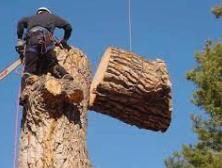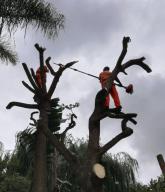10 Steps to Growing Trees

10 Easy steps to planting, feeding and caring for your tree:
A Guide from Windy Willows.
1. Locating the tree: Trees need room to grow their branches above the ground and their roots below the ground. Avoid planting too close to overhead telephone or power lines, or too close to buildings. Most medium sized trees should be located at least 2 meters from any wall. Check whether your tree has an aggressive root system and needs to be further than 2 meters from any wall or building. Some trees have large surface roots and will lift paving. Deciduous trees will give shade in summer and let the sun through in winter. Large evergreen trees are often inappropriate for smaller gardens as they block out the sun and make the house dark and cold (especially in winter).
2. Digging the hole: Measure the size of the bag that the tree came in – dig your hole twice as deep and twice as wide. This has the effect of loosening the soil immediately around the roots and allowing the tree to quickly expand its root size. If the soil is rock or slate you might want to make the hole a little larger in order to give the tree more space to grow.
3. Compost mix: Divide the soil that you took out of the ground in half. This is the amount of soil that would be needed to replant the tree. Make a pile of compost equal in size to the remaining soil. The pile mixed with compost will be used to plant the tree. Do not mix the soil and compost yet. A 20L or 40L tree will half a bag (20 dm) of compost per tree. A 100L tree will require a full bag of compost. A 250L tree will require two bags of compost, etc..
4. Adding compost and water: Fill the tree hole up to the 1/3 level with compost from your pile. Now fill the hole (with the compost in it) with water – fill to the brim. Let the water seep completely into the ground. You will notice that the hole is now lined with compost. This will encourage the roots of the tree to spread faster. (Note: if the water takes longer than half an hour to drain out of the hole then you have a soil drainage problem (too much clay in the soil) and you may need to make a much larger hole – see article on planting in clay soils). Now mix the remainder of the compost with the soil you set aside for planting. This is your planting mix which the tree will initially grow in. Within 6 to 9 months the major roots will have gone beyond this mix into the surrounding soil to anchor the tree. The feeder roots (the smaller ones) will remain mostly in this richer planting mix.
5. Applying fertilizer: You are now ready to plant your tree. Put one large handful of bonemeal at the bottom of the hole. Spread it over the entire bottom. Bonemeal stimulates root growth and will further assist the tree in its development. You may also want to add some slow release fertilizer tablets (eg., Agriform tablets). These tablets release controlled quantities of food to the tree over a two year period. By the end of this period the tree will be able to fend for itself in the ground. While this is not essential it will ensure that the tree has access to the range of nutrients required for balanced growth. At a cost of around R5 per tablet this is an inexpensive way to give the tree an added boost.
6. Planting the tree: Now remove the plastic bag from the tree carefully so as not to disturb the roots. The best way to do this is to slit the plastic bag along the side with a scissors and then pull the bag off the tree.
It is better if the soil in the bag is not too dry or too wet when doing this. Dry soil will simply fall away and possibly damage the small roots. Very wet soil will also be difficult to work with. Damp soil is best. When planting the tree take care to ensure that it remains at the level that it was in the bag. Do not plant the trunk deeper in the soil than it was in the bag or the stem may rot leading to possible death of the tree. Stamp the tree down in the hole after planting which will create the basin around the tree (see step 8). Ensure that the soil is firm around the tree and that the tree is standing upright. When you have finished planting the tree create a basin about 5cm deep around the tree to retain water. The basin should be about 80cm in diameter.
7. Staking the tree: Most nursery propagated trees come in a bag with a single stake. The stem of the tree is probably only a few centimetres thick as the tree was grown in close proximity to many other trees – leading it to grow tall rather than thick. Trees need to bend in the wind in order to strengthen, but strong winds can snap off the head of the tree. In order to ensure healthy growth, support your tree between two stakes rather than against one. Push a strong stake into the ground on either side of the tree and use old hosepipe or rubber hose to create a loop around the stakes (with the tree in the middle). In the case of a tall tree two or three such loops can be created at different heights along the stem. The hose should be firmly secured onto the stakes (with a nail or a screw through the hose into the stake) but not secured to the tree. This will allow the tree to sway but not to break in strong wind. Don’t overstake a tree. A year’s staking is often enough.
8. Mulch the tree to conserve water. Trees that grow in nature often have 5 – 10 cm of mulch that has accumulated around the base of the tree. This conserves the water in the soil and creates a healthy environment for the development of micro-organisms in the soil. Don’t let the grass grow up to the base of the tree. Trees are at a disadvantage when they have to compete with lawn for water, air and nutrients. Create a basin around the tree when planting (at least 60cms in diameter) and fill the basin with mulch. Bark chips are ideal for mulch (can be bought from the Nursery) or garden leaves or pine needles from the garden. Do not use lawn cuttings as these tend to matt and prevent drainage.
9. Watering the tree: Watering frequency should ideally depend on the soil and not the calendar. Check the soil 10cm below the surface level: Soil that feels moist when squeezed together does not need water. Overwatering drives the air from the soil and can cause root suffocation and root rot. Most plants do not like to stand in moist soil for long periods. Frequent, light watering, promotes shallow root development. Mulching the tree conserves water usage. In the hot summer trees will often need to be watered three times per week if there is no rain. In winter deciduous trees do not need to be watered. Evergreen trees can be watered once a week.
10. Pruning your tree: A newly planted tree only needs minimal pruning. Prune out only the dead, diseased or injured branches. Transplanted trees establish quicker when as much foliage as possible remains. Lower branches may need to be pruned in order to establish a canopy. Do not cut the lateral branch off flush against the main trunk; prune one to two cm’s from the main trunk as this helps support and strengthen the trunk. After the first year cosmetic pruning can be done: Prune the vigorous growers in order to maintain the desired shape (a concentrated ball or canopy).

